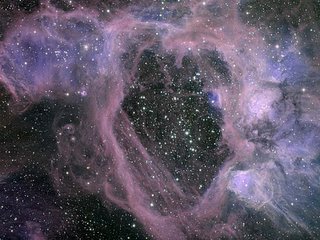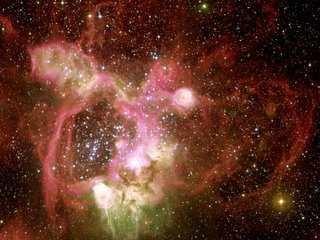The N44 Superbubble

What created this gigantic hole?
Astronomers believe one or more of the stars in the cluster blew up, blowing out a hole about 325 by 250 light-years across.
N44 is one of the largest and most intricate nebulas in this part of the universe. Located in
our galactic neighbor the Large Magellanic Cloud, N44 houses numerous massive bright stars, lengthy lanes of dark dust, and vast clouds of hydrogen gas that glows red.
N44 is classified as an emission nebula because it contains large regions of ionized hydrogen. A close analysis of N44's tunnel-like structure can tell astronomers a lot about the dynamics behind cosmic blasts. One possibility is particle winds expelled by massive stars in the bubble's interior that are pushing out the glowing gas. This answer has been recently found to be inconsistent with measured wind velocities, however.
Another possibility is that the expanding shells of old supernovas have sculpted the unusual space cavern. An unexpected clue of hot X-ray emitting gas was recently been detected escaping the N44 superbubble. The above image, here digitally sharpened, was taken in three very specific colors by the huge 8-meter Gemini South Telescope on Cerro Pachon in Chile.
 The red color of the N44 emission nebula comes from pervasive hydrogen atoms re-acquiring electrons that were knocked away by energetic light from massive stars. The central stars also appear to have somehow created the huge superbubble visible in the lower left. N44, pictured beside, spans about 1,000 light years and lies about 170,000 light years distant.
The red color of the N44 emission nebula comes from pervasive hydrogen atoms re-acquiring electrons that were knocked away by energetic light from massive stars. The central stars also appear to have somehow created the huge superbubble visible in the lower left. N44, pictured beside, spans about 1,000 light years and lies about 170,000 light years distant.A combinde image of visible light with images in infrared light and X-rays, provided by ESO.
At the centre of this very rich region of gas, dust and young stars lies the star cluster NGC 1929. Its massive stars produce intense radiation, expel matter at high speeds as stellar winds, and race through their short but brilliant lives to explode as supernovae. The winds and supernova shock waves have carved out a huge cavity, called a superbubble, in the surrounding gas.
 Observations with NASA's Chandra X-ray Observatory (shown here in blue) reveal hot regions created by these winds and shocks, while infrared data from NASA's Spitzer Space Telescope (shown in red) outline where the dust and cooler gas are found. The visible-light view from the MPG/ESO 2.2-metre telescope (in yellow) completes the picture and shows the hot young stars themselves as well as the glowing clouds of gas and dust that surround them.
Observations with NASA's Chandra X-ray Observatory (shown here in blue) reveal hot regions created by these winds and shocks, while infrared data from NASA's Spitzer Space Telescope (shown in red) outline where the dust and cooler gas are found. The visible-light view from the MPG/ESO 2.2-metre telescope (in yellow) completes the picture and shows the hot young stars themselves as well as the glowing clouds of gas and dust that surround them.








0 Comments:
Post a Comment
<< Home